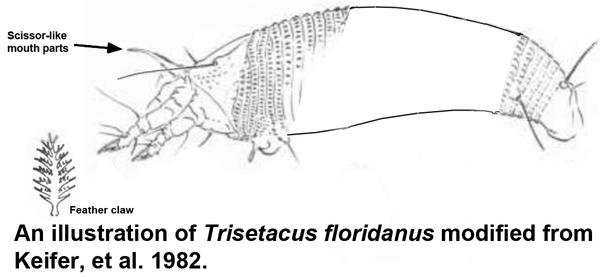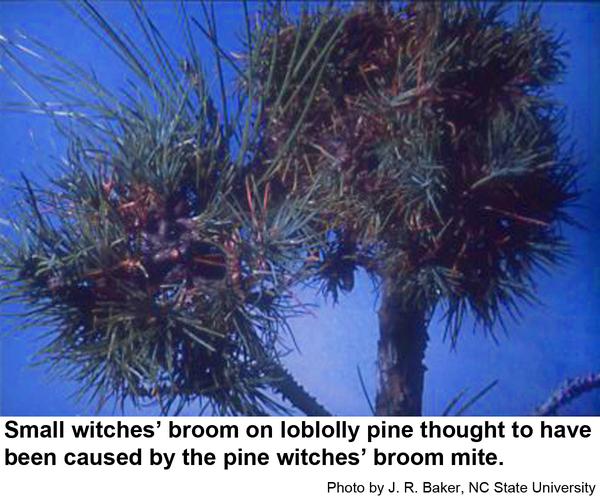Description and Biology
Pine witches' broom mites, Trisetacus floridanus and other closely related eriophyid mites, cause noticeable bunched growth on pines often referred to as witches or witch's brooms. Eriophyid mites are unusual in that they have only four legs situated at the front of a worm-like, cylindrical body. Pine witches' broom mites are extremely small (280 to 375 microns long—just visible with a 10X hand lens), and the abdomen has 65 to 70 encircling rings with microscopic bumps. The tiny legs each have a feather claw with eight rays on each side. The light yellowish white female mites lay relatively large eggs from which hatch first nymphs that grow and molt into second nymphs that grow and molt into adult mites. Like many eriophyid mites, Trisetacus mites inject their saliva into their hosts as they feed. This saliva acts like a plant growth regulator by shortening stem growth and encouraging numerous adventitious buds to form (the witches' broom). Specimens have been collected in growing terminal shoots from January through August. Pine witches' broom mites probably overwinter in bark crevices and under bud scales. We probably have several generations per year in North Carolina.
Host Plants
Pine witches' broom mites have been reported attacking terminal shoots and causing galls, aborted buds, and stunted needles on "pine," sand pine, slash pine, and cedar pines.
Residential Recommendations
Should pine witches' broom mites become so abundant on a specimen tree in the landscape that control seem necessary, Sevin insecticide is effective for eriophyid mite suppression. Use a sprayable formulation for better results.
Other Resources
- A Gall Mite, Trisetacus floridanus K., on Florida Pines (Acarina: Eriophyidae). Denmark, H. A. 1971. Florida Department of Agriculture and Consumer Services Entomology Circular No. 104.
- An Illustrated Guide to Plant Abnormalities Caused by Eriophyid Mites in North America. Keifer, H. H.,et al. 1982. USDA ARS Agr. Handbook No. 573. 178 pages.
- NC State Extension Plant Pathology Publications
- NC State Horticultural Science Publications
- North Carolina Agricultural Chemicals Manual
For assistance with a specific problem, contact your local Cooperative Extension center.
This factsheet has not been peer reviewed.
Publication date: July 22, 2020
Recommendations for the use of agricultural chemicals are included in this publication as a convenience to the reader. The use of brand names and any mention or listing of commercial products or services in this publication does not imply endorsement by NC State University or N.C. A&T State University nor discrimination against similar products or services not mentioned. Individuals who use agricultural chemicals are responsible for ensuring that the intended use complies with current regulations and conforms to the product label. Be sure to obtain current information about usage regulations and examine a current product label before applying any chemical. For assistance, contact your local N.C. Cooperative Extension county center.
N.C. Cooperative Extension prohibits discrimination and harassment regardless of age, color, disability, family and marital status, gender identity, national origin, political beliefs, race, religion, sex (including pregnancy), sexual orientation and veteran status.



